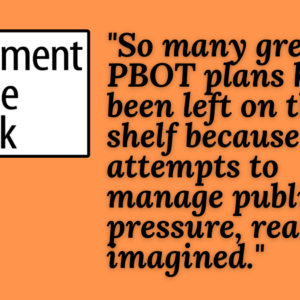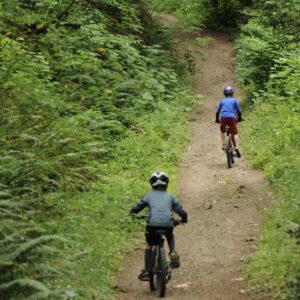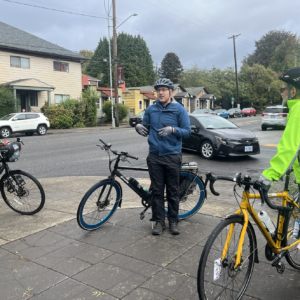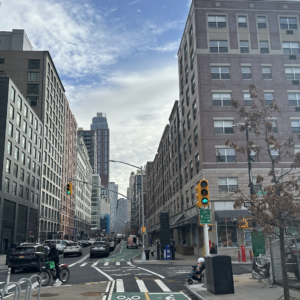The Office of Transportation has published the first bit of their Bicycle Master Plan online. It’s a draft of an introduction to the Existing Conditions Report and it sheds light on how the city sees Portland’s cycling future.
The report starts out stating how far we’ve come since the plan was last updated in 1996,
“In the past decade bicycling has truly become an integral part of daily life for thousands of Portlanders.”
But it also points out we have a long ways to go,
“And yet, Portland is still only capturing the tip of the iceberg of potential bicycle trips.”
Citing the seemingly ubiquitous presence of cycling in Portland’s culture, media, politics, and news, it says,
“Bicycling in Portland is here to stay. Bicycling in Portland has a future.”
Then it gets interesting,
“The intent of this document is to formalize and organize the conversation about what that future will be. The result of this conversation will be to chart the future of bicycling in Portland. Will bicycling in Portland follow the model of the past decade and continue to make modest inroads into the daily lives of Portlanders—attractive as a means of daily transportation only to that minority of residents confident enough to mix, as they inevitably must, with high volumes of automotive traffic…
Or, and more hopefully, will the future of bicycling in Portland leap upon the gains already made and upon the native expertise and burgeoning social and health trends here and begin to ascend toward the status of world-class bicycling city, American-style?…Ultimately, it all comes down to questions of priorities in design and effort.”
That’s the big question. Can Portland planners and bureaucrats prioritize a safe and efficient bikeway network above all the institutional (and political) barriers they will be faced with?
In order to break new ground as a “world-class bicycling city,” we’ll have some tough hurdles to overcome.
Read the full chapter here (PDF).





Thanks for reading.
BikePortland has served this community with independent community journalism since 2005. We rely on subscriptions from readers like you to survive. Your financial support is vital in keeping this valuable resource alive and well.
Please subscribe today to strengthen and expand our work.
Something that seems to be missing in Portland is a lack of emphasis on recreational riding. While the commute/urban riding is great, the MTB crowd has been able to highlight lack of recreational infrastructure. I ditto that for road bike riding… in the City, while it is easy, it is not that invigorating, and the county roads can be a hazard as recent events have made clear. A recreational path ala the Spingwater, but with out the gaps and better pavement would be a nice addition. Sacramento has a fantastic trail along its rivers.
Perhaps the present lack of dedicated recreational riding infrastructure is because it makes more sense to get day-to-day transport infrastructure taken care of first? Just think, Portland could have been like other cities and sunk the money they use for cycling-related projects into miles and miles of MUPs and made a hell of a lot less inroads to pushing cycling as a practical transport solution.
Now that cycling in Portland *is* a practical means of transport for thousands, the emphasis can stand to be shifted. Attacking it in the reverse order would\’ve accomplished little other than \”we\’ve got a recreation path which people *drive* to, unload their bikes, and have a fun time on the weekends…and oh yeah, a few folks who don\’t live too far from it might use it for transport, while only the daring or stupid brave the streets for day-to-day transport cycling\”, which is *exactly* how it is in many other places.
This once again is leading into the eternal controversy between the \”vehicular cycling+rider and motorist education\” school of thought vs the \”bikeway\” school of thought. I for one believe that the best way to promote cycling is for more people to be seen out there doing it, and that there is a real danger of promoting separate rights-of-way for use by commuter cyclists. I can\’t count how many times I\’ve heard a motorist say something like \”You don\’t belong on this road! Get in the bike path!\”
All comments thus far have good points.
We can all agree, then, that the conversation appropriate for this junction is: \”How much change? How fast? Where? and Why?\”
As motorists become fewer and alternative transportation grows, I believe the answer lies in gaging how much change is inevitable and how much change is possible when encouraged by government. Somewhere in the middle should be our golden cookie.
mmm, cookie
I do think a certain network of bike paths is important (in part due to the fact that they\’re handy and dandy for recrational riding) though I feel that making the roads safer for cyclists is just as important if not more so. A large part of that is just getting more people to ride more often. I was on a road yesterday that I ride just about everyday (SE 12th) but today there were two other cyclists as well. That was all it took. I got WAY more respect than I usually do. All the cars moved into the other lane to pass, and nobody complained.
That said, I feel like one of the best ways to encourage more people to ride is to make the roads FEEL safe, even to a beginner and even when you\’re the only cyclist on the road.
\”I got way more respect than I usually do\”…(riding down SE 12th). Martha S. maybe we should start with changing the perceptions many motorists have of cyclists before we get too far ahead. Hopefully you\’re not floating in the middle of the lane during a.m. or p.m. rush hour. That can\’t be too safe or popular with most of the drivers at those hours. Then we can work on the \”feeling safe\” part.
SE has the largest ridership in the region. As a result people who live / work / and frequent SE are used to seeing and driving around bikes.
The weekend before last I was waiting for some friends at SE Division / 21st / Ladds Addition intersection. The one with the New Seasons, Starbuck, Pastini Pastaria, and whatnot. I watched for about half an hour and there were as many bikes as cars navigating the intersection. (It was a really nice day). They were all styles of bikes too, some road bikes and spandex wearing riders, some scrubby old beat up bikes with baskets, some BMX, some commuter style with racks and fenders, some families with tag-a-longs and trailers.
But definitely bikes everywhere.
Now head out to Tanasborne in Hillsboro. Say at 185th and Cornell or 185th and Evergreen Parkway. That area has MANY MANY more stores and restaurants – but you wont see more than a couple bicycles on the best of days.
Part of what makes roadways safer is drivers are used to being around bicycles and pedestrians.
A difficult chicken and egg type problem, indeed.
And yes, I know that Hillsboro is not part of Portland\’s bike master plan. I am just illustrating a point…